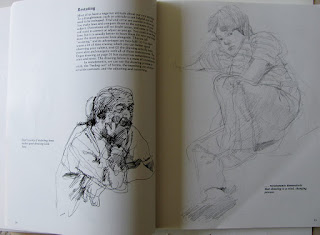I may have mentioned this book before as Charles Reid told me, when on a workshop, that he considered it the best book on drawing. This is a bold statement as there are hundreds of books on drawing and Charles can't possibly have read all of them. They vary from the classical style `Atelier' type publications to every variation on the theme. Having bought it I certainly agree with him from my point of view. I have several others, including classics, but I prefer the `looser' style of Charles and Dodsons book, while covering all types, is more to my taste.
Keys to Drawing - Bert Dodson. North Light Books this edition paperback 1990 224 pages approx. 81/2" x 103/4"
Current Amazon prices - Hardback £16.30p, Paperback £14.88p , From Amazon partners used and new from £6.64p Also Kindle edition.
Here are some examples from the book.
I realised after doing this that I had skimped it rather and can only apologize for my befuddled state. Following a weeks holiday in Malta I returned and immediately went down with a raging cold and cough. Here are some of the things the book teaches:
55 specific keys to improving your drawing.
48 mini lessons that help you master techniques
8 self evaluation checklists to help you gauge your progress
In addition it teaches you to restate, focus, map and intensify. Free your hand action, then learn to control it.
Convey the illusions of light, depth, and texture etc Enough said to kindle your interest?






7 comments:
This is a very good book. I push it on people as much as possible. It does favor a very loose line approach which has a lot of appeal. But, again, when learning to draw, people tend to see the loose line approach as an easy out and not really representative of true drawing, which generally means very tight work. In fact to most of the public, it's seen as doodling or sketching. It's terribly frustrating because, from my experience, it's the looseness that allows the viewer to participate in the work, filling in spots here and there, whereas a tight painting or drawing has pretty much spelled it out for you, leaving the viewer to be just that: a viewer.
Excellent book Peter, though I do agree with Oscar's comments.
Nice to hear from you again Oscar after a while. Don't you think drawing, like everything else in art, is subject to the art police who want to dictate what is good and what isn't? I can admire the technique of those who paint or draw super realistically but it leaves nothing to the imagination.
Thanks Ray for comments. See my reply to Oscar.
Ah, the art police. It's unfortunate that they are every where. From critics to, worse, painters and drawers who dictate stupid things like never center the subject, don't mix this color and that, the list goes on. A subset of the art police is the tool police: don't use this, use this, never paint on this kind of paper, etc. I think I've touched on this before.
Regarding painting and drawing tightly, while I stand by my thoughts regarding it, I find that that the work of Andrew Wyeth, while tight, always allows me to swim around in it. I don't know why that is the case here, but I believe that Wyeth brings something, a mystique, or otherworldliness, for lack of a better word, to his works. And, if I may add, his pencil works are superb. Wyeth is my favorite painter.
Peter,
It is policing in terms that modernists installed the police, persecution, jury and the judge. Anyone objecting against their terms is immediately persecuted because they now claim the art world and academia. 'Ars moderna' has very much strangled drawing, because to them, it was an unnecessary rational layer between an artists and the chosen medium of expression. It was something like abolishing the moral law of conduct; they felt it must be taken away so that painting comes out freely.
Ars moderna started in central Europe, in same countries in which psychoanalysis started too, in about same time, and both suggested same ideas: limit rules and, ultimately, have no rules whatsoever. Feel bad about your frustration of being a mediocre painter? Get rid of drawing! That is what stifles your prospects. Remove that boring, controlling layer. Similarly, we had in psychoanalysis a very similar approach; got tired of frustration about being condemned to relationship only in marriage? Craving others? Craving this impulse or that? Break the rule: promiscuity is fine, and recommended for mental health.
Over the time, both those and similar angsts against rules exploded, and as a consequence, we in the art world today have lost much of understanding what drawing really is. What Charles Reid suggested as a good book on 'drawing', was in fact considered as mere ink or charcoal sketching centuries before, or, very basic 'disegno'. But for today abilities, even that is overcomplicated.
Disegno is not drawing, only training mind to think, and hand to move in a comprehensible way. It is an effort to make some sense into a composition. Drawing is a step that follows after this step, but today, anything not done with paint and brushes is considered 'drawing'. We have lost even the vocabulary of drawing to be able to recognise it anymore.
Thank you. ZMWT
Thanks Oscar and Zvonimir for your comments and thoughts.
Post a Comment